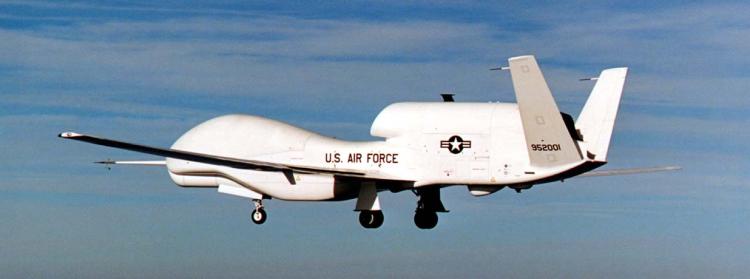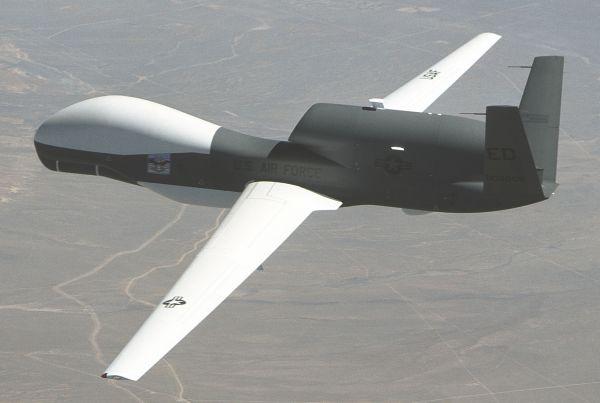Northrop Grumman (Teledyne Ryan) RQ-4 Global Hawk
MQ-4 Triton
The Global Hawk is the U.S. Air Force's first operational UAV in the HAE (High Altitude Endurance) category. Its development began in 1994, when DARPA issued a request for proposals for their "Tier II+" HAE UAV requirement. In March 1995 an ACTD (Advanced Concept Technology Demonstration) contract was awarded to Teledyne Ryan Aeronautical (now part of Northrop Grumman), and in January 1997, the designation RQ-4A was officially allocated to the Global Hawk UAV. The first of five ACTD vehicles flew for the first time in February 1998. The EMD (Engineering and Manufacturing Development) phase of the program began in March 2001, and in February 2002, low-rate initial production was approved.
 |
| Photo: USAF |
| RQ-4A |
The RQ-4A is powered by a Rolls-Royce/Allison F137-RR-100 (model AE 3007H) turbofan. It takes off and lands on conventional runways using a retractable tricycle landing gear. The airframe has the typical layout of a high-endurance UAV, and the prominent nose bulge houses the wideband SATCOM antenna of 1.2 m (4 ft) diameter. The vehicle can reach an altitude of 19800 m (65000 ft) and has a maximum endurance of at least 36 (and possibly up to 42) hours. A Global Hawk system consists of two RQ-4A UAVs and two major ground stations, the RD-2A Mission Control Element (MCE) and the RD-2B Launch and Recovery Element (LRE). The LRE is used to load autonomous flight data into the UAV's GPS/INS navigation system, control the vehicle during take-off and landing, and monitor its flight performance. The MCE personnel controls and monitors the UAV's sensor systems. Both LRE and MCE can control three RQ-4As simultaneously. The main components of the RQ-4A's ISS (Integrated Sensor Suite) for its surveillance, reconnaissance and target acquisition missions are an SAR/MTI (Synthetic Aperture Radar/Moving Target Indicator) and IR/EO (Infrared/Electro-Optical) sensors. For self-defense, the UAV is equipped with an AN/ALR-69 radar warning receiver and AN/ALE-50 towed decoys.
 |
| Image: Northrop Grumman |
| RQ-4A |
The RQ-4A has already been used operationally during Operation Enduring Freedom in Afghanistan. Despite the loss of one of the two deployed vehicles, the operations were considered a success. By mid-2005, the USAF had received a total of 12 Global Hawk UAVs, and the requirement at that time was for up to 58 aircraft (including the later RQ-4B model, q.v.).
The designation YRQ-4A has been assigned to RQ-4A aircraft which are modified to evaluate new technologies and components for the general improvement of the performance of the Global Hawk system. Similarly, modified MCEs and LREs have been designated YRD-2A and YRD-2B, respectively.
 |
| Photo: Northrop Grumman |
| RQ-4A |
In April 2003, the designation RQ-4B was assigned to an enlarged derivative of the RQ-4A. The first flight of an RQ-4B occurred on 1 March 2007. Compared to the RQ-4A, the RQ-4B has a 50% higher payload capability and carries additional SIGINT (Signal Intelligence) and ELINT (Electronic Intelligence) payloads. The initial RQ-4B configuration is also known as Global Hawk Block 20 (Block 10 is the RQ-4A). The next upgrade of the RQ-4B was the multi-intelligence Global Hawk Block 30 with new EO/IR, SAR, and high and low band SIGINT sensors. Block 30 reached IOC with the USAF in 2011, and in the same year, the USAF retired the remaining RQ-4A Block 10 aircraft. The ultimate RQ-4B version is the Block 40, which carries an AN/ZPY-2 AESA (Active Electronically Scanned Array) radar developed under the Multi-Platform Radar Technology Insertion Program (MP-RTIP). The new radar provides SAR data, and also MTI (Moving Target Indication) data for wide-area surveillance of stationary and moving targets. Block 40 IOC was achieved in 2015.
 |
| Photo: Northrop Grumman |
| RQ-4B |
Beginning around 2010, a total of five RQ-4B Block 20 aircraft were converted to EQ-4B configuration, carrying the BACN (Battlefield Airborne Communications Node) system. BACN is a multi-platform communications relay system to provide wide-area tactical information in real-time. Apart from the EQ-4B, BACN was also installed in the USAF's E-11A aircraft. The EQ-4B has seen extensive service in the middle East and over Afghanistan, with the loss of one aircraft in 2011 due to the failure of an onboard electromechanical unit. In 2021, the Air Force retired its remaining EQ-4B assets, leaving the E-11A as the only BACN platform.
 |
| Photo: USAF |
| EQ-4B |
The USAF has purchased a total of about 45 RQ-4A/B aircraft. As of 2022, only nine Global Hawk Block 40 remained in service, and the Air Force has announced plans to retire the type by the end of 2027. This has been interpreted as an indication, that classified replacements like the alleged "RQ-180" are already operational.
Global Hawk is also operated by non-US customers. The air forces of Japan and South Korea use the RQ-4B, while NATO has purchased the RQ-4D Phoenix, based in the RQ-4B Block 40, for its Alliance Ground Surveillance (AGS) requirement. The first RQ-4D was delivered in 2019, and IOC was reached in February 2021.
 |
| Photo: Northrop Grumman |
| RQ-4D |
In the early 2010s, the German Bundeswehr also had plans to operate a small fleet of Global Hawk UAVs. The German version was known as RQ-4E Euro Hawk (even though RQ-4E was never reserved as an official DOD MDS designation), and was to be an RQ-4B fitted with a SIGINT payload by EADS. However, the RQ-4E project was terminated after the delivery of only one aircraft.
MQ-4 Triton
The U.S. Navy was evaluating the Global Hawk from 2005 on as an unmanned maritime surveillance platform under the GHMD (Global Hawk Maritime Demonstration) program. The first RQ-4A for the Navy flew in October 2004. In April 2008, the Navy selected the Global Hawk as the winner of its BAMS UAS (Broad Area Maritime Surveillance Unmanned Aircraft System) competition. Initially known under the informal label RQ-4N, the BAMS Global Hawk has been designated MQ-4C Triton by the U.S. Navy. The first flight of an MQ-4C occurred on 22 May 2013. Compared with the RQ-4B, the MQ-4C airframe has a reinforced structure, de-icing systems and lightning protection, to enable the aircraft to operate in clouds and adverse weather.
 |
| Photo: U.S. Navy |
| MQ-4C |
The primary mission of the MQ-4C is maritime ISR (Intelligence, Surveillance and Reconnaissance), but the aircraft can also serve as a communications relay or assist in search-and-rescue missions. The main ISR sensor is a Northrop Grumman AN/ZPY-3 MFAS (Multi-Function Active Sensor) AESA radar. The ground control stations for Triton are designated MD-3A (Main Operating Base, MOB, for 6 operators) and MD-3B (Forward Operating Base, FOB, for two operators). EOC (Early Operational Capability) of the MQ-4C with the U.S. Navy was declared in 2020, while IOC was finally reached in September 2023, many years later than originally planned. By that time, the Navy had received five MQ-4C, of a planned total purchase of 27 aircraft.
In the 2017/18 time frame, the German Bundeswehr had plans to buy a variant of the Triton under the project mame PEGASUS (PErsistant German Airborne SUrveillance System). The MDS designation MQ-4D had been assigned to the Triton aircraft with Bundeswehr-specific modifications. However, Germany cancelled the purchase in 2020. As of 2024, the only non-US operator of the Triton is the Royal Australian Air Force.
Specifications
Note: Data given by several sources show slight variations. Figures given below may therefore be inaccurate!
Data for RQ-4A/B:
| RQ-4A | RQ-4B | |
|---|---|---|
| Length | 13.53 m (44 ft 4.75 in) | 14.50 m (47 ft 7 in) |
| Wingspan | 35.42 m (116 ft 2.5 in) | 39.90 m (130 ft 11 in) |
| Height | 4.64 m (15 ft 2.5 in) | |
| Weight | max: 12130 kg (26750 lb); empty: 6710 kg (14800 lb) | max: 14630 kg (32250 lb) |
| Speed | 648 km/h (403 mph) | 574 km/h (357 mph) |
| Ceiling | 19800 m (65000 ft) | 18300 m (60000 ft) |
| Range | 21720 km (11730 nm) | |
| Endurance | 36 h | > 34 h |
| Propulsion | Rolls-Royce/Allison F137-RR-100 turbofan; 33.8 kN (7600 lb) | |
Main Sources
[1] Kenneth Munson (ed.): "Jane's Unmanned Aerial Vehicles and Targets, Issue 15", Jane's, 2000
[2] Tom Kaminski: "The Future is Here", article in Combat Aircraft Vol. 4, No. 6, 2003
[3] Northrop Grumman Website
[4] "Unmanned Aircraft Systems Roadmap, 2005-2030", Office of the Secretary of Defense, August 2005
[5] U.S. Air Force: RQ-4 Global Hawk Fact Sheet, 2014
[6] Key Aero, Dave Allport: USAF retires BACN EQ-4B Global Hawks,
August 2021
[7] U.S. Navy: MQ-4C Triton Fact Sheet
[8] Northrop Grumman:
Northrop Grumman MQ-4C Triton Achieves Initial Operating Capability with the US Navy, September 2023
[9] Various web resources, referenced by Wikipedia: Northrop Grumman
RQ-4 Global Hawk, Northrop Grumman MQ-4C Triton and
Alliance Ground Surveillance Force
Back to Directory of U.S. Military Rockets and Missiles, Appendix 2
Last Updated: 28 December 2024